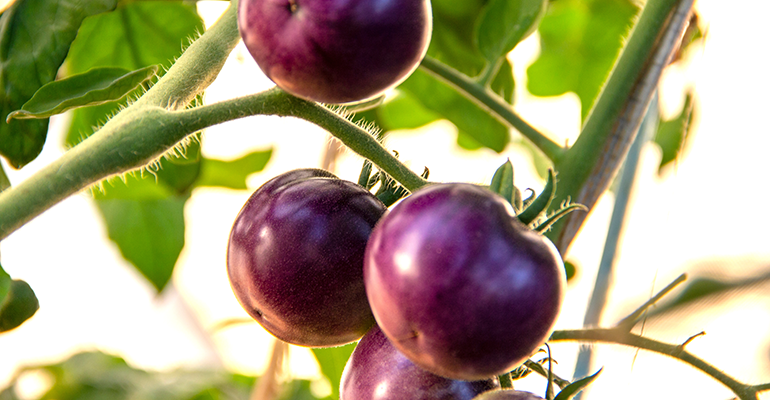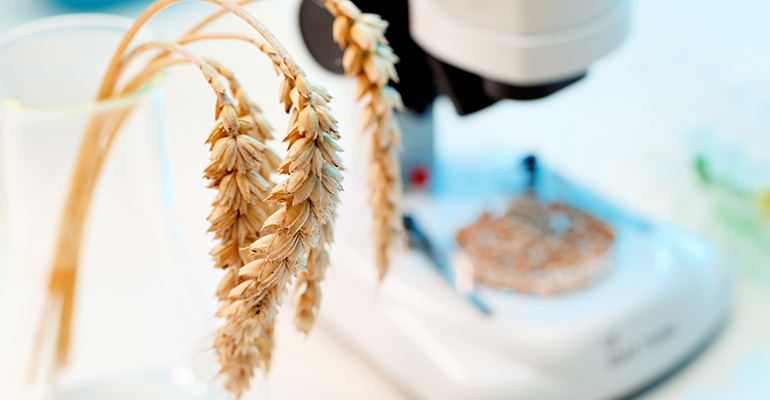News
Are consumers ready for purple GM tomatoes?
15 Jun 2023
Genetically modified (GM) purple tomatoes, developed by a UK company, are hitting the shelves in the US following regulatory approval last year. But are consumers ready to eat purple tomatoes – even if they are high in healthy anthocyanins?
Last September, the United States Department of Agriculture authorised purple tomato seeds, developed by UK-based Norfolk Plant Sciences while in March this year, the UK government passed the Genetic Technology (Precision Breeding) Act. The UK law enables the development of new crop varieties that are more resistant to pests, healthier to eat, and more resilient to drought and heat as climate changes.

“After many decades researching the science that can make our crops resistant to disease and less reliant on fungicides, I am delighted to finally see changes in legislation that will allow some of these innovations to be applied in the field and benefit UK farmers and the UK environment,” said Professor Jonathan Jones, group leader at The Sainsbury Laboratory.
Professor Jones is a founding member of Norfolk Plant Sciences (NPS), a spin-out from the John Innes Centre and The Sainsbury Laboratory that is gearing up to launch the breed of GM-purple tomatoes that contain high levels of anthocyanins in the US later this year.
“While I would’ve hoped to see the same proportionate regulations also apply to other, more established, plant breeding technologies such as genetic modification, I think enabling gene editing for crop improvement is a step in the right direction,” he added.
According to the start-up, which has a presence in Davis, California and Boston, Massachusetts as well as in Norwich, UK, these tomatoes contain the highest levels of anthocyanins, comparable to antioxidant levels in superfoods like blueberries.
A brief history of GM tomatoes
But are customers ready for this new brand of tomato, especially after previous efforts to introduce GM tomatoes fizzled out amidst a backdrop of anti-GMO sentiment?
Biotechnology firm Calgene launched the FLAVR SAVR tomato back in 1994, genetically modified to resist fungal damage and increase shelf-life. After Calgene was bought by Monsanto, the tomato disappeared in 1997.
Meanwhile in the UK, FLAVR SAVR tomatoes were licensed out to Zeneca, which produced a brand of tomato puree. The product was withdrawn in 1999 after the term “Frankenstein Foods” was attached to GM products, stoking unfounded fears among the buying public.
However, the reintroduction of GM tomatoes could be different with the product tapping into many consumer food trends such as suitability in ‘on-the-go’ snacks, and reduced waste, thanks to a longer shelf life.
‘Consumers open to bioengineering approaches’
“Tomatoes with anthocyanins can be made by traditional breeding and engineering,” said NPS. “We believe that both approaches have advantages and can appeal to different consumers.
“Research shows that many consumers are open to bioengineering approaches to improve the nutrition and sustainability of their food. Other consumers prefer non-GMO verified and organic options, which are readily available today.”
Perhaps the food’s strongest selling point is its health benefits, made possible by adding two genes from snapdragons that work like “on switches,” triggering the production of antioxidants in the whole tomato and not just the skins.
And it’s not just levels of antioxidants that can be adjusted in tomatoes with levels of vitamin D also proving open to genetic modification.
“This is a beautiful piece of work that demonstrates how GE can be used to provide consumers with a plant based source of Vitamin D, either by consuming the fruit itself or as a supplement that makes use of the waste products of tomato production (the leaves),” said Dr Penny Hundleby, Senior Scientist at the John Innes Centre, in response to a 2022 study looking at GM tomatoes and vitamin D levels.
“With food security, sustainability and climate change high on the agenda – making the foods we grow and eat as nutritious as possible, while also reducing waste, supports these goals.”
 © AdobeStock/luchschenF
© AdobeStock/luchschenF
Gene-edited wheat with lower acrylamide levels
With the success of the Impossible Burger, which contains GM soy protein and haem protein made in fermentation tanks by genetically engineered yeast, the argument is that consumers, mindful of environmental and sustainable pressures, are more open to new ways of food production.
The work gone into producing the purple tomato is now being replicated in other food crops, suggesting a commercial confidence in the approach already reflected at the governmental and regulatory level.
Researchers at Rothamsted Research in the UK have carried out Europe’s first ever trial of a variety of wheat, gene-edited to lower the formation of asparagine its grains. In conventional wheat, this amino acid is converted to the suspected carcinogen acrylamide when cooked at high temperatures.
“The study showed that gene editing to reduce asparagine concentration in the wheat grain works just as well in the field as under glass,” explained Professor Nigel Halford, who led the research.
“The availability of low acrylamide wheat could enable food businesses to comply with evolving regulations on the presence of acrylamide in food without costly changes to production lines or reductions in product quality.
“However, [genetic engineered] GE plants will only be developed for commercial use if the right regulatory framework is in place and breeders are confident that they will get a return on their investment in GE varieties,” he added.
